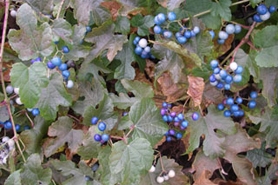Porcelain berry
(Ampelopsis brevipedunculata)
Deciduous perennial vine; stems have lenticels; white pith; may grow up to 15 feet in one season.
Other names for this plant include:
- Common names: Amur peppervine, porcelain vine, varigated porcelain berry
- Scientific names: A. glandulosa var. brevipedunculata; A. brevipedunculata var maximowiczii
Classification in Wisconsin: Prohibited
- Ecological Threat
-
- Shades out native vegetation by forming a dense blanket.
- It also climbs up trees and shrubs increasing the possibility of downing during storms.
- Prefers moist woods, floodplains, stream banks and woodland edges.
- Identification
-
Leaves: Shapes vary from heart to palmately lobed with tendrils opposite of the dark green leaves. Leaves dissected. Hairs present on the leaf veins.
Flowers: Small green-white flowers bloom in clusters during mid-summer.
Fruits & seeds: Shiny, clustered berries occur in fall and are a range of colors from pink to purple to blue with small white and gray spots; the flesh is white.
Roots: Fibrous and can resprout from root fragmentation.
Similar species: Native grapes (Vitis spp.) are also woody vines but with shredding bark when mature. Leaves are sometimes hairy, but generally on the surface of the leaf and sometimes on the veins. Stem pith is brown compared to porcelain berry’s white pith and the fruit of native grapes are green, black, or purple and watery.
Refer to the ID guide for porcelain berry, provided by Frank Hassler of Good Oak Ecological Services, for assistance with the identification of porcelain berry during the winter.
- Control
-
Mechanical: Vines can be pulled from trees and cut or mowed to prevent flowering. This will not eradicate but will control. Small plants can be hand-pulled before fruit.
Chemical: Cut stump with glyphosate; basal bark in fall with triclopyr and surfactant.
- Resources
- Sources for content:
- Czarapata, Elizabeth; Invasive Plants of the Upper Midwest: an illustrated guide to their identification and control. University of Wisconsin Press. 2005. Pg. 127
- Sarver, M.J., A. Treher, L. Wilson, R. Naczi, and F.B. Kuehn, 2008. Mistaken Identity? Invasive Plants and their Native Look-alikes: An Identification Guide for the Mid-Atlantic. Dove, DE: Delaware Department of Agriculture and USDA Natural Resources Conservation Service. Pg 28-29



